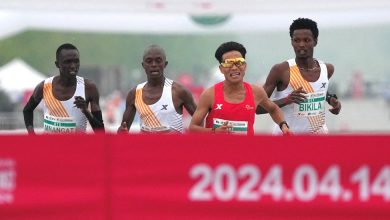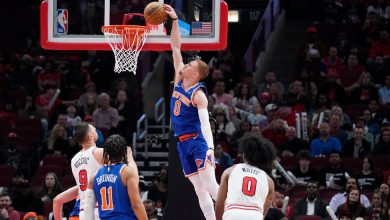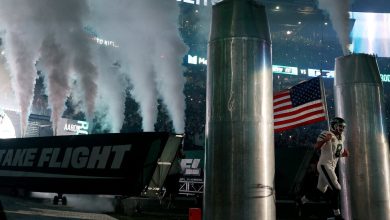A Master of the Goal Mouth Gets Better As He Goes

It was a typical day of practice for Chris Kreider, another morning skate at the Rangers facility in Tarrytown, N.Y., like hundreds before it. Toward the end, Kreider planted himself in front of Igor Shesterkin, the Rangers goalie, while a phalanx of teammates fired slapshots in their direction.
One by one, as the pucks sizzled through the air toward them at roughly 100 miles per hour, Kreider calmly tipped them with his stick. Some pinged off the crossbar, some bounced down into the goal, a few deflected into Shesterkin’s padding. But Kreider got his stick on virtually every one of them.
To the novice eye it was an uncanny display of hand-eye coordination, born from thousands of hours of practice and a unique natural skill. It was also reminiscent of the craft required of a baseball batter facing a darting fastball, something Kreider did obsessively while growing up in Boxford, Mass., just north of Boston.
“Hitting a baseball, that was something that I did for a very, very long time,” Kreider said, “and there are similarities.”
But batters don’t have other players in front of them, blocking their view of the incoming projectile, or an opposing player jabbing a stick into their back, trying to shove them away from the crease.
That hard-fought patch of ice around the opponents’ goal is where Kreider does his best work, particularly on the Rangers potent power play. It is where Kreider has come to be recognized — especially this year — as one of the best in the world, drawing comparisons to the great Sidney Crosby and to Joe Pavelski, who is considered by many to be a master in front of goal.
This year, Kreider may have surpassed them. With a career-high 34 goals, he is third in the N.H.L. and leads the league with 17 goals on the power play.
This from a player who had never scored more than 28 goals in any of his first nine seasons in the N.H.L. But this year, Kreider scored 12 in January alone, some with his back to the goal.
“He’s one of the best I’ve seen tipping pucks,” said Adam Fox, the Rangers top defenseman. “Some goals, like the power play ones when he’s tight to the post and able to chip it by the goalie, you don’t see many people do that. You see Crosby do it, and he’s one of the best players in the league.”
A few of Kreider’s 34 goals were laser wrist shots from the wing, but most were redirected from the side, tipped home or shoveled in off rebounds. Sometimes it was both, like on Thursday, when Kreider skated backward to his favored spot in front of goal and tipped a shot that was temporarily kept out by Washington Capitals goalie Ilya Samsonov. But Kreider gathered the rebound and fired it home from close range with the goalie out of position.
It was quintessential Kreider. But circulating like a shark around the net was not always Kreider’s game.
“I was a very different player in high school,” he said, noting that he changed his style after college to maximize his value at the highest level. That evolution has produced one of the most dangerous players in the league.
In his youth, Kreider was a sight to behold on rinks around New England. Faster, stronger and more skilled than virtually all of his schoolboy and later college competitors, Kreider zipped from one end to the other with the puck dangling on his stick as defenders and teammates struggled to keep up.
Garnet Hathaway, a winger for the Washington Capitals, recalls being one of those players, often lagging a zone behind. He met Kreider when they were sophomores at Phillips Andover Academy, not far from Kreider’s hometown, and the pair became instant friends. Hathaway spent one summer living at Kreider’s family home in Boxford and marveled at his friend’s relentless drive and overwhelming desire to win at everything he did.
“There were all the tattered nets he went through in their driveway and all the pucks lost in the woods,” Hathaway recalled. “He was a freakish athlete. We spent the summer training, working out, and then he’d want to play basketball and he’d be dunking and trying to beat his sister in a game. Then we go inside and play some board game and he would win at that, too.”
Hathaway, who made it to the N.H.L. despite not getting drafted, said that from the moment Kreider arrived at Andover, he exhibited a dedication to work — even with no coaches around — that he called, “infectious.”
One evening, after an Andover practice, Hathaway, Kreider and another teammate were headed to Kreider’s gym in the pouring rain for an additional workout, until they noticed a flat tire. Hathaway assumed the gym session would be abandoned. Kreider never entertained the thought. He insisted they fix the tire in the rain, and then they went to the gym.
“I consider myself lucky to have been around him to get that competitive push,” Hathaway said. “It helped me get better. If you surround yourself with smart, hard-working people who are friendly, that’s the best you can do.”
Later, at Boston College, Kreider was still one of the best skaters on a national championship team. But it was there, he said, that coaches first began to usher him toward the goalmouth and tutor him on the art of screening the goalie, tipping and redirecting pucks, and anticipating the exact place to be. Once he joined the Rangers, he said, that process intensified and as his professional career unfolded he continued to morph from flash to grit, from Pavel Bure into Phil Esposito.
Drafted 19th overall in 2009, Kreider has already assembled an impressive Rangers career, even if he never scores again. His 211 goals are 12th on the Rangers’ career list, where he and Brian Leetch are the only Americans in the top 20. With 625 games played, Kreider is 23rd on that team list and through Friday he was ninth in plus/minus with plus-82 over 10 years.
He and Victor Hedman, the all-world defenseman for the Tampa Bay Lightning, are the only players in the first round of their draft class that are still with the same team, an indication of their stature.rIt is a notable accomplishment for someone whose earliest fantasy was to be a professional baseball player. Kreider said he was obsessed with the game when he was young. A catcher, he understood the importance of recognizing the unique movement of a pitcher’s ball as it approached the plate. Today, he applies that same approach to his teammates’ slapshots.
He said K’Andre Miller’s shot tends to rise and he likened Fox’s diving slapper to a split-finger fastball, except for one recent game when it rose.
“That surprised me, like a passed ball,” Kreider joked, as the old catcher in him briefly emerged. “The runner would have gone to second.”
When a new defenseman comes to the Rangers, Kreider stands behind them in one of their first practices with the team to gauge how the puck moves off their sticks, before he gets in front of them to practice his tip-ins.
It is the kind of attention to detail that has helped Kreider evolve from a whiz-kid, puck-handling skater to one of the most feared net-front players in hockey, and to carve out a career year already, with 30 games still to play.
“I don’t think anyone is surprised by it,” said Jacob Trouba, the Rangers defenseman. “He’s scored a lot of them around the net. He knows what he’s good at and he puts himself in positions to be successful.”



